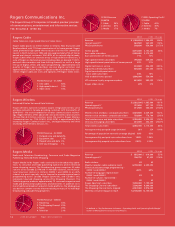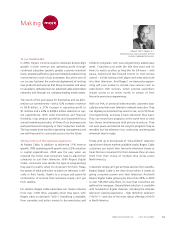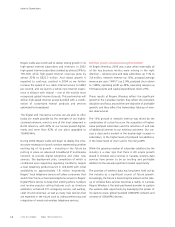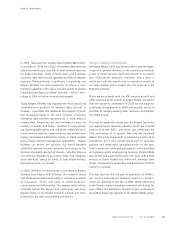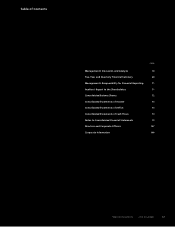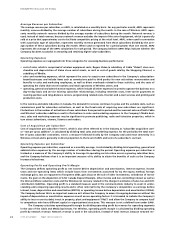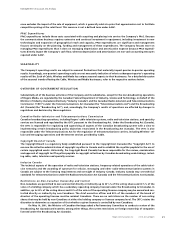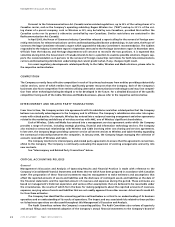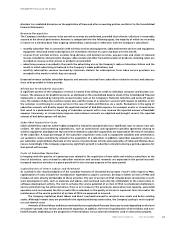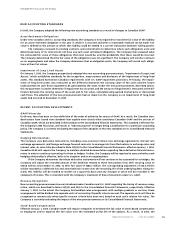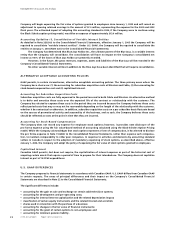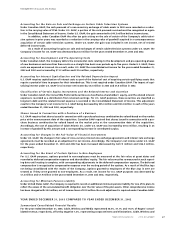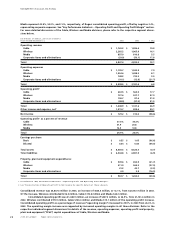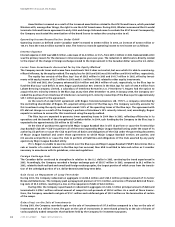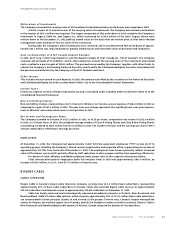Rogers 2003 Annual Report Download - page 24
Download and view the complete annual report
Please find page 24 of the 2003 Rogers annual report below. You can navigate through the pages in the report by either clicking on the pages listed below, or by using the keyword search tool below to find specific information within the annual report.
2003 Annual Report Rogers Communications Inc.
22
Management’s Discussion and Analysis
Pursuant to the Telecommunications Act (Canada) and associated regulations, up to 20% of the voting shares of a
Canadian carrier, such as the Company’s operating subsidiary Rogers Wireless Inc. (“RWI”) and up to 331/3% of the vot-
ing shares of a parent company, such as Wireless or RCI, may be held by non-Canadians, provided that neither the
Canadian carrier nor its parent is otherwise controlled by non-Canadians. Similar restrictions are contained in the
Radiocommunication Act (Canada).
In April 2003, the House of Commons Industry Committee released a report calling for the removal of foreign own-
ership restrictions for telecommunications carriers and broadcasting distribution undertakings. In June 2003, the House of
Commons Heritage Committee released a report which opposed the Industry Committee’s recommendation. The Cabinet
responded to the Industry Committee report in September 2003 and to the Heritage Committee report in November 2003.
Officials from the Industry and Heritage departments will convene to reconcile the two positions. It is expected that
sometime during 2004, the Government of Canada intends to be in a position to examine possible solutions. Rogers sup-
ports the recommendation as it pertains to the removal of foreign ownership restrictions for both telecommunications
carriers and broadcasting distribution undertakings but cannot predict what, if any, changes might result.
For recent regulatory developments related specifically to the Cable, Wireless and Media divisions, please refer to
the respective sections below.
COMPETITION
The Company currently faces effective competition in each of its primary businesses from entities providing substantially
similar services, some of which entities have significantly greater resources than the Company. Each of the Company’s
businesses also faces competition from entities utilizing alternative communications technologies and may face competi-
tion from other technologies being developed or to be developed in the future. For a detailed discussion of the specific
competition facing each of the Cable, Wireless and Media businesses, please refer to the respective sections below.
INTERCOMPANY AND RELATED PARTY TRANSACTIONS
From time to time, the Company enters into agreements with its subsidiaries and other related parties that the Company
believes are mutually advantageous to the Company and its affiliates. The Company’s subsidiaries also enter into agree-
ments with related parties. For example, Wireless has entered into a reciprocal roaming arrangement and other agreements
related to the marketing and delivery of wireless services with AWE, one of Wireless’ significant shareholders.
Each of Wireless, Cable and Media has entered into a management services agreement under which the Company
provides a range of services, including strategic planning, financial and information technology services. The Company
also maintains contractual relationships with Wireless and Cable involving other cost sharing and services agreements.
In late 2001, the Company began providing customer service call centre services to Wireless and Cable thereby expanding
the contractual relationships between the companies. In January 2003, the Company began managing the collection of
accounts receivable of Wireless and Cable.
The Company monitors its intercompany and related party agreements to ensure that the agreements remain ben-
eficial to the Company. The Company is continually evaluating the expansion of existing arrangements and entry into
new contracts.
See “Intercompany and Related Party Transactions” below.
CRITICAL ACCOUNTING POLICIES
General
Management’s Discussion and Analysis of Operating Results and Financial Position is made with reference to the
Company’s Consolidated Financial Statements and Notes thereto which have been prepared in accordance with Canadian
GAAP. The preparation of these financial statements requires management to make estimates and assumptions that
affect the reported amounts of assets and liabilities and the disclosure of contingent assets and liabilities at the date of
the financial statements and the reported amount of revenues and expenses during the period. These estimates are
based on management’s historical experience and various other assumptions that are believed to be reasonable under
the circumstances, the results of which form the basis for making judgments about the reported amounts of revenues,
expenses, carrying value of assets and liabilities that are not readily apparent from other sources. Actual results could dif-
fer from these estimates.
The Company has identified the accounting policies outlined below as critical to an understanding of its business
operations and an understanding of its results of operations. The impact and any associated risks related to these policies
on its business operations are discussed throughout this Management’s Discussion and Analysis.
The Audit Committee reviews the Company’s accounting policies. The Audit Committee also reviews all quarterly
and annual filings and recommends adoption of the Company’s annual financial statements to the Company’s board of


